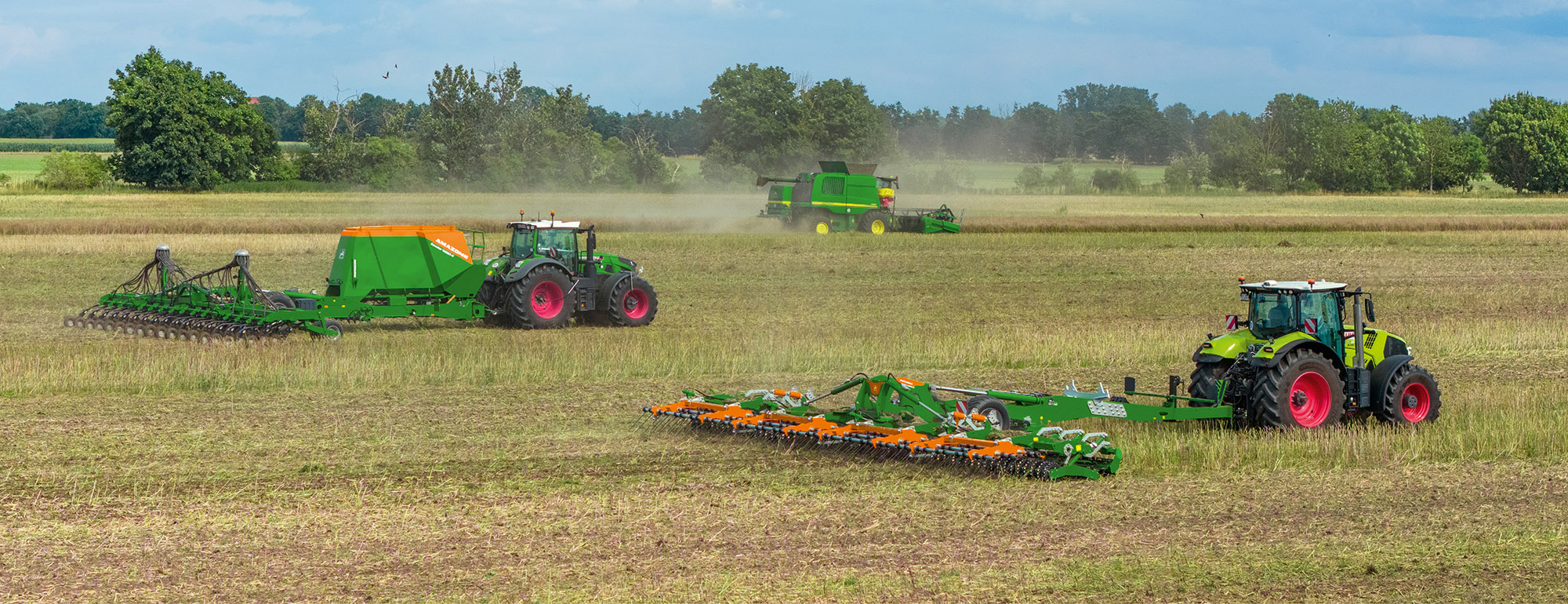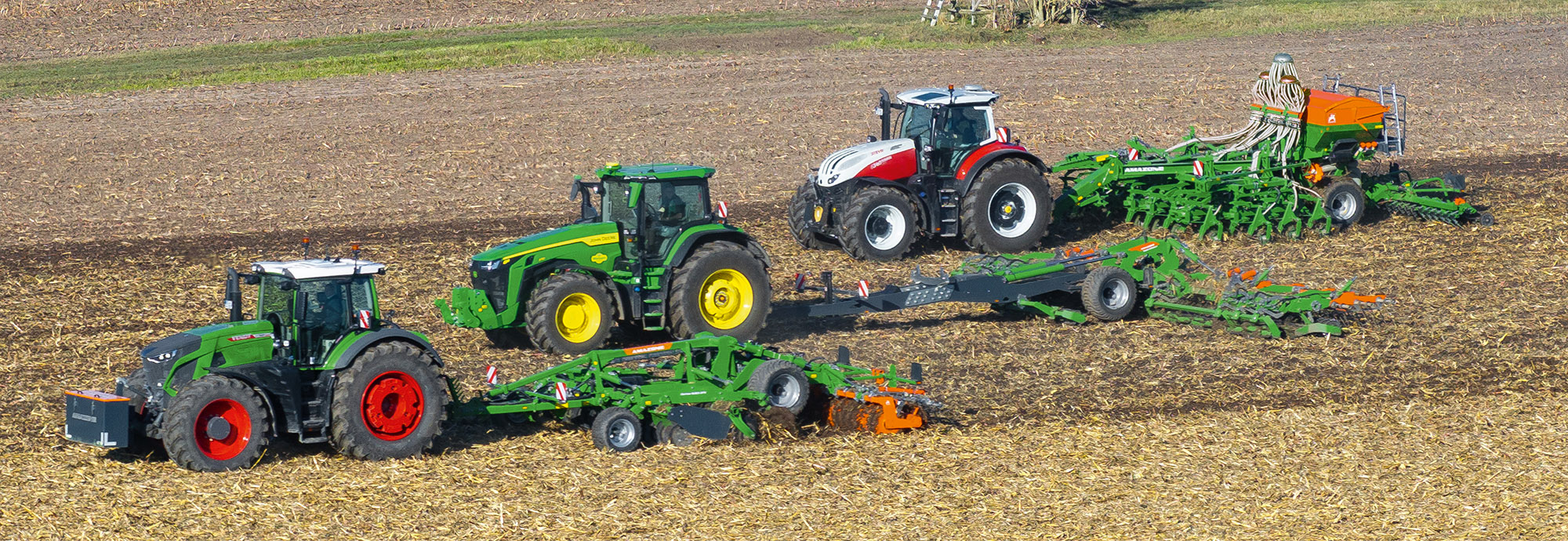Cut ’n' Sow – direct seeding taken a step further
Innovative establishment chain for modern and successful sowing
Cut 'n' Sow - first cut, then sow!
With the innovative Cut 'n' Sow process, AMAZONE presents pioneering machine combinations of ultra-shallow soil tillage and direct sowing for the most demanding of conditions - an ideal solution, especially for tall and tough organic material. The combinations of the new TopCut cutting roller combination and the tried and tested Cayena, Condor or Primera DMC tine coulter seed drills, as well as the Cirrus trailed cultivator drill with Minimum TillDisc form cost-effective establishment chains that provide answers to the central challenges of modern arable farming.
Direct sowing in transition - recognising opportunities and challenges and offering solutions
Direct sowing is becoming increasingly important - not only in classic dry regions, but also in high-yield locations with intensive crop rotations. In combination with cover cropping, this method promises considerable advantages: protection of the soil structure, erosion control and an active contribution to humus conservation and humus formation. However, with the growing increase in direct sowing, new challenges are also emerging that require differentiated solutions.
In classic no-till regions, for example, there is an increasing problem with organic material on the soil surface: Straw mats, dead catch crops and undecomposed plant residues can make seedbed preparation and field emergence considerably more difficult and block seed drills. At the same time, high-yield areas with intensive biomass production place very specific demands on machinery and processes. Here, too, it becomes clear: the balance between soil protection, residue management and successful establishment of the main cash crop is challenging - and crucial to the success of the system.
This is exactly where we come in with our Cut 'n' Sow solutions. With tried-and-tested technology and agronomic expertise, we support farmers in implementing direct sowing efficiently and reliably, even under difficult conditions. This is because the key to successful direct sowing lies in adaptation - to the location, crop rotation and residue situation.
TopCut cutting roller combination and tine coulter seed drill: perfectly combined - from cutting to sowing
The TopCut works ultra-shallow (0 to 3 cm) and ensures the shredding and even distribution of organic crop residues, whether they be catch crops, cereal stubble, sunflower stubble, rape stubble or maize stubble. In addition, an optional harrow improves straw distribution; particularly effective for post-harvest cultivation at right angles to the direction of sowing. Thanks to the minimal working depth, the soil structure is fully preserved, capillarity is interrupted and valuable soil moisture is conserved at the seed horizon. An optimum seedbed is created!
Another advantage of the TopCut is that it not only cuts up organic material in the surface soil, but also produces fine soil at the same time. Especially on heavy ground, additional fine soil can be generated in a targeted manner - this improves seed/soil contact when sowing and supports an even field emergence. A clear advantage for robust crops when using the no-till method.
By shredding the crop residues, the AMAZONE direct sowing seed drills can be used to sow under the mulch layer into the moist and cool soil. Thanks to the preliminary work of the TopCut, direct sowing is now much more reliable and resilient to blockages, even with its otherwise natural application limits such as tough, long-stemmed organic matter. In addition to the increased operational reliability, the seed drills also leave a more even quality of work in the establishment chain when direct sowing. Time-consuming mulching of extreme straw levels is not necessary, as the AMAZONE coulter technology guarantees reliable contact between seed and soil, even under difficult conditions. For example, precise furrow clearing avoids so-called hair pinning, i.e. placing the seed in the seed furrow along with the straw - even with straw quantities of over 10 tonnes per hectare.
While the seed is now placed and finds optimal conditions for germination, the organic soil mixture lies on top of the seed like a protective blanket. This prevents the evaporation of water and overheating of the soil.
Another advantage of direct sowing with tine coulters or sowing with minimum TillDisc discs is the targeted, yet low soil movement: minimal loosening and crumbling of the soil not only creates an active seedbed, but also reliably and evenly closes the seed furrows. In contrast, direct sowing with a disc coulter without preparatory work can lead to furrow wall compaction - especially where the disc cuts and the depth guide roller runs. Consequences: the furrows do not close completely, which can lead to uneven field emergence. The establishment chain offers a practical alternative with decisive agronomic added value.
A central problem of direct sowing - especially with intensive catch crops or previous cereal crops - is the large amount of organic residues that often remain on the soil surface in the form of straw mats or dead plant residues. These layers can make seed placement more difficult, impair field emergence and also provide an ideal microclimate for soil-borne pathogens, such as fungal pathogens like Fusarium. The lack of contact with the fine soil also hinders rotting, so that organic material is retained for too long and can lead to a much more difficult start for the new crops.
This is exactly where Cut 'n' Sow comes in: by cutting up and simultaneously mixing the crop residues with the fine soil produced in the surface, rotting is promoted and decomposition of the material is significantly accelerated. While the soil life works on the organic remains of the previous crop, the new crop can emerge under ideal conditions. By the time the next crop is harvested, the residues have almost completely broken down - diseases are prevented and the natural cycle begins anew. This combination of residue management and precise seed placement makes Cut 'n' Sow an effective problem-solver in the modern no-till system.
Effective pest control
With its aggressive mode of operation, the cutting roller combination also makes a significant contribution to field hygiene. Slug populations are reduced effectively - a clear advantage when direct sowing oil seed rape, for example. Driving over the crop stubble once or several times provides reliable protection against slugs and snails and ensures consistent rape crops. The corn borer beetle is also controlled by the knife rollers and optional cutting rollers. The stubble is shredded down to its roots so that water can penetrate and protection against frost is no longer guaranteed. This means that direct sowing can be carried out with a seed drill after the maize harvest without the need for inversion soil tillage.
Practical example
With a 6 m wide TopCut at 20 km/h and a Primera DMC 6000-2 with a working width of 6 m at 14 km/h, up to 100 ha can be covered in 8 hours with the TopCut, and around 70 ha with the Primera DMC. This low-input strategy secures and improves profitability, particularly on marginal sites, and at the same time enables climate-adapted yet flexible arable farming. Flexible, since the system can be supplemented with classic soil tillage if required. If, for example, winter wheat is sown late in the year in a moist location after grain maize, more intensive soil tillage has the advantage of mixing in the straw volumes, breaking up compaction and aerating the soil at the same time. Due to the deep penetration, however, the seedbed is usually rough and coarsely structured. Here, too, the TopCut can impress by preparing a fine soil seedbed in just one cost-effective pass. The knife rollers cut the clods and crumble the surface soil effectively. If the seedbed is to be reconsolidated, a wedge ring roller with matrix tyre profile*, with 600 mm diameter tyres, can be mounted on the TopCut 12000-2T instead of the rear harrow.
Conclusion: sustainability meets efficiency
Cut 'n' Sow is the answer to the increasing demands of climate change and pest pressure as well as the challenges of economic arable farming. The universal combination of TopCut and tine coulter seed drills offers future-proof, robust and soil-protecting solutions for modern arable farming.
*not in combination with the leading tool
The perfect seedbed in a single pass: the Cut 'n' Sow process combines ultra-shallow soil tillage and high area output with resource-optimised sowing, making it a powerful answer to the challenges of modern agriculture:
- Effective: mechanical weed control, reduction in slug populations, promotion of straw rotting
- Reliable: no bulldozing of long organic material, no blockages on the tine coulter - even under extreme conditions.
- Sustainable: humus preservation, erosion protection and protection against drying out, protection of soil life
- Economical: low diesel consumption of the TopCut from 2 l/ha, reduced wear, high area coverage with minimum labour requirements
Gallery


